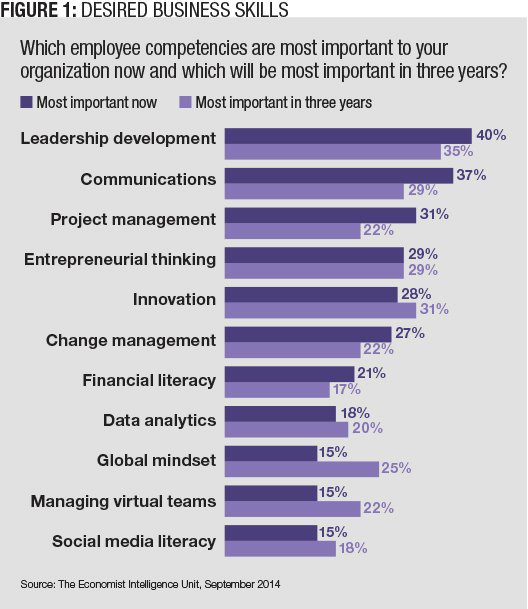In a global business environment, where changing demographics and technology affects the ways in which business is conducted, companies must stay ahead of competition.
Investing in employee development is a requirement, not only to improve productivity, better serve customers and strengthen company culture but also to recruit and retain talented next-generation executives and foster innovation.
In June 2014, the Economist Intelligence Unit surveyed 295 executives from around the world toexplore the ties between workforce development and business outcomes on behalf of CrossKnowledge and Future Workplace. These executives — evenly balanced across the Asia-Pacific, Europe, Latin America and North America — represent a wide variety ofindustries such as IT, financial services, telecommunications and manufacturing, and occupy a variety of C-suite roles. Half of their companies have annual revenue of more than $500 million, and a quarter report annual revenue of at least $5 billion.

After analyzing the survey results, a picture emerged around shared perceptions about talent development. What follows will detail what business leaders expect from training, what they think of its value and what they see as the main benefits from learning investments. These ideas influence how companies will approach workforce development in the future.
What Do Leaders Want From Learning?
To keep up with an ever-evolving marketplace, corporations are searching for new kinds of competencies in their workforce as well as in their new recruits. Leadership development will remain a priority, but companies will look specifically for a globalmindset in candidates.
Cross-cultural talents, such as the ability to work together to achieve successful business results, are becoming essential to companies as they continuously increase profits and deliver value outside of their home markets. Now and over the next three years, companies also will be looking for the ability to manage virtual teams (15 to 22 percent), social media literacy (15 to 18 percent) and innovation (28 to 31 percent). More traditional skills, such as project management, are expected to decline to 22 percent from 31 in the next three years. Financial literacy will drop to 17 percent from 21 (Figure 1).

C-level executives are also willing to invest in learning to guarantee their employees are business-oriented. When asked what business outcomes would justify a substantial investment in workforce development, 55 percent answered increased productivity and 40 percent said greater responsiveness to new opportunities in the marketplace. Essentially, long-term strategic business stakes are seen as valuable outcomes that warrant training investments. Short-term indicators such as positive return on investment (22 percent) or reduced costs (18 percent) are not as valued(Figure 2).

Other business outcomes that would justify a substantial investment in workforce development include increased employee engagement (39 percent), higher profitability (37 percent) and lower turnover (36 percent). C-levels are looking for hard business metrics to measure the impact of workforce development, and they are ready to unlock budgets if it serves companywide business objectives.
Training Key to Attract, Retain Talent
Attracting and retaining the best talent is a real competitive advantage. It’s also an essential challenge for top management. Salary and benefits are still perceived as the most effective way to recruit and retain, but investment in employee development is a close second: 35 percent indicate this type of investment will be critical. Executives also understand that workplace flexibility (28 percent) and strong corporate values and responsibility (23 percent) are important to attract top talent.
The survey results also show that traditional advantages such as profit sharing (16 percent) and incentives like gym, food and transportation (12 percent) rank far below learning and development strategies as recruiting and retention tools (Figure 3).
Workforce development is a high priority because it generates large payoffs. The fast-paced, global marketplace in which companies evolve today calls foremployees and managers to strive for continuous self-improvement. Fortunately, some 94 percent said workforce development requires continuousinvestment and improvement.

Further, 82 percent believe workforce development contributes to business success. This statistic suggests that effective learning and development skills lead to a tangible, satisfactory return on investment. Savvy C-suite executives will demonstrate their belief that workforce development is not a source of cost, but rather an investment in the companies’ success (Figure 4).
When C-levels were asked about the most effective delivery modes to foster successful learning experiences, they identified mentoring, peer-to-peer sharing and massive open online courses as new ways to learn, all prevailing on more traditional forms of learning (Figure 5).

The Future of Development
They also pointed to informal and social learning. Executives admit that adults learn more from informal and social training, in agreement with the 70-20-10 model, according to which 70 percent of all learning is done on the job, 20 percent from peer interaction and only 10 percent through formal learning.
The corollary of the surge of social learning is as training becomes tailor made and customized to individual needs, standardized, open enrollment offerings in business schools decline.
Initially, MOOCs affected higher education most because they were primarily used to develop academic competencies, democratizing learning and making it accessible to a larger crowd. This disruption is now spreading to corporate learning.

Companies increasingly wish to integrate TED Talks into learning and curate MOOCs, providing they can align them with the competencies they want to develop or are developing in their workforce. Companies are also creating their own MOOCs, to develop internal employee training programs as well as to provide learning opportunities for external stakeholders. C-levels are adopting the idea that learning is not just a passing experience but also a lifelong process, and they’re using MOOCs to make this concept a reality (Figure 6).
Big Obstacles
The executives surveyed agree that insufficient development of learning management systems and inadequate financial resources constitute the biggest obstacles to workforce development. Indeed, 43 percent of respondents cited them as the top two difficulties their companies face in developing long term,results-driven training.

Lack of financial resources is a significant quandary, even more so for smaller firms; half of those firms’ leaders cited it as a main obstacle compared with only 36 percent for larger companies. Insufficient engagement of HR and learning specialists is also notable barrier to learning strategy at 39 percent.
Technology in learning is also viewed as a considerable impediment: learning management systems are not viewed as innovative enough, and are currently not meeting companies’ needs. To become a means of empowerment rather than an obstacle, learning management systems need to shift their attention to rising learner engagement and allow real-time learning customization (Figure 7).
Workforce development is a high priority for global companies because it generates large payoffs in the form of business outcomes, profitability and employee engagement. Learning leaders should make creating a development-centric culture within their workforce one of their main objectives. Investing in staff will lay the groundwork for success at a companywide level.















